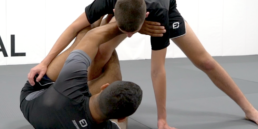Here’s a great article I came across by Professor Stephen Kesting in regards to training dangerous leg locks! Especially in our day and age, it is even more imperative to learn, know, and understand the leg lock game.
Q: Given that leg locks are dangerous, how do you train them safely and still have confidence that they will work in a ‘live’ setting.
A: Although ANY submission is potentially dangerous, cranking someone with a heel hook or toehold can not only end the match, it can end your opponent’s athletic career.
These two leg locks are dangerous because they are twisting submissions and can severely damage ligaments in the knee and foot. Furthermore, for most submissions, the pain starts well before there is any damage to the joint.
With twisting leg locks, however, you often don’t feel much initial pain: as someone is applying it to you might not feel anything at all, then you might feel a bit of discomfort, and then BANG, you feel a lot of pain because something has popped or torn.
So how do you train these dangerous locks so that you can trust in their effectiveness? My answer has 4 parts:
1 – Learn and fight for the leg lock positions, not the submissions
One of the beautiful things about the modern leg lock game is that leg locking has, to a large degree, become a positional game rather than a sprint for the finish.
That means that you can spend an entire sparring session working on getting into specific positions and maintaining them against a training partner who is pretty much doing everything he can to get out of those positions and catch you in them.
There are about 12 major positions in leg locking. Some positions are easy to get to but not super-powerful to finish from, and others take more work to get into but are crazy powerful finishing platforms.
Position before submission, not just for upper body attacks anymore!
2 – Master the straight ankle lock and the kneebar
When applying 95% of leg locks you end up either facing your opponents head or facing his feet. The mechanics of controlling your opponent in these two positions are relatively similar whether you are doing a ‘safe’ straight lock or a ‘dangerous’ twisting lock.
The straight ankle lock teaches you how to control your opponent’s legs, body, and body weight when you are facing his head. The mechanics and techniques to control your opponent in this position translate well to controlling your opponent when attacking with a heel hook (and some variations of the toehold).
The knee bar is the cornerstone leg lock for learning how to control your opponent when you are facing his feet: once you master the knee bar you will have a lot more confidence maintaining positions where you are facing your opponent’s feet while attacking with other techniques (the toehold, for example).
I should emphasize that just because straight ankle locks and knee bars are fairly safe submissions this DOESN’T give you permission to apply them ballistically.
At full power and full speed, these ‘safe’ submissions can still screw up someone’s joints pretty badly (just like any other joint locks). Apply them with control, and remember it is far better to have someone counter your submission because you were applying it too slowly, rather than injuring them and losing a training partner.
3 – Apply dangerous leg locks with control
Most sensible people who want to include toeholds and heel hooks in their grappling practice catch-and-release sparring when it comes to these two submissions. They fight hard to get to the right body position, then hunt for the correct hand position, and then hold the submission loosely (or apply it very slowly and very gently). At this point BOTH PARTNERS STOP MOVING and acknowledge that the submission probably would probably have worked if it had been applied hard and fast.
All that is lacking in this type of sparring is the final explosion into the submission. If you understand how to control your opponent with your legs (by practicing the ankle lock and knee bar), and you know how to get to the correct hand position for the heel hook and toehold (by practicing catch-and-release sparring) then you can be fairly certain that your techniques will work in a live situation.
4 – Pick your sparring partners carefully.
Obviously, catch-and-release sparring doesn’t work if either party is a) too caught up in their ego to stop contesting a lock once it is on, or b) too inexperienced to know that they, or their partner, are in danger. Don’t do these leg locks with a newbie, or the class spaz, or the guy who won’t tap out unless he hears something pop or the guy who needs to submit everyone hard and fast.


